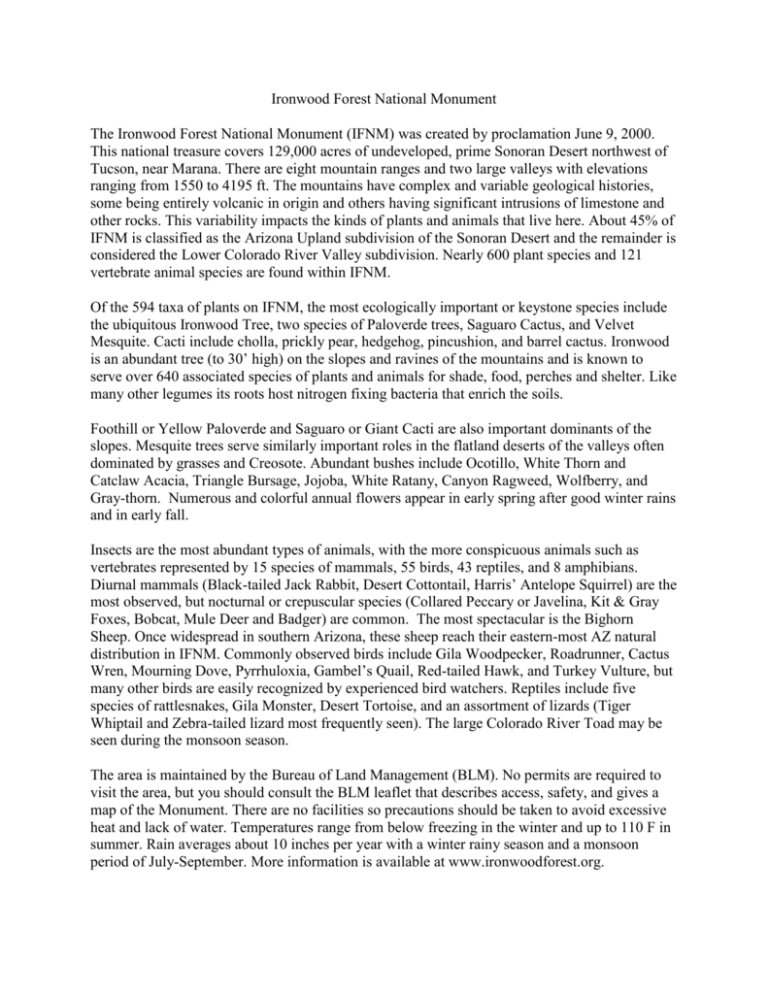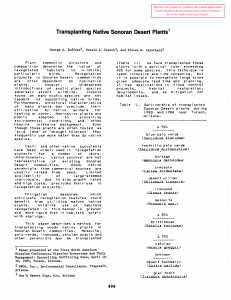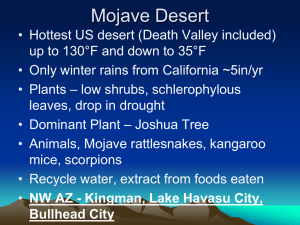IronwoodForestNationalMonumentDescriptionOnePager
advertisement

Ironwood Forest National Monument The Ironwood Forest National Monument (IFNM) was created by proclamation June 9, 2000. This national treasure covers 129,000 acres of undeveloped, prime Sonoran Desert northwest of Tucson, near Marana. There are eight mountain ranges and two large valleys with elevations ranging from 1550 to 4195 ft. The mountains have complex and variable geological histories, some being entirely volcanic in origin and others having significant intrusions of limestone and other rocks. This variability impacts the kinds of plants and animals that live here. About 45% of IFNM is classified as the Arizona Upland subdivision of the Sonoran Desert and the remainder is considered the Lower Colorado River Valley subdivision. Nearly 600 plant species and 121 vertebrate animal species are found within IFNM. Of the 594 taxa of plants on IFNM, the most ecologically important or keystone species include the ubiquitous Ironwood Tree, two species of Paloverde trees, Saguaro Cactus, and Velvet Mesquite. Cacti include cholla, prickly pear, hedgehog, pincushion, and barrel cactus. Ironwood is an abundant tree (to 30’ high) on the slopes and ravines of the mountains and is known to serve over 640 associated species of plants and animals for shade, food, perches and shelter. Like many other legumes its roots host nitrogen fixing bacteria that enrich the soils. Foothill or Yellow Paloverde and Saguaro or Giant Cacti are also important dominants of the slopes. Mesquite trees serve similarly important roles in the flatland deserts of the valleys often dominated by grasses and Creosote. Abundant bushes include Ocotillo, White Thorn and Catclaw Acacia, Triangle Bursage, Jojoba, White Ratany, Canyon Ragweed, Wolfberry, and Gray-thorn. Numerous and colorful annual flowers appear in early spring after good winter rains and in early fall. Insects are the most abundant types of animals, with the more conspicuous animals such as vertebrates represented by 15 species of mammals, 55 birds, 43 reptiles, and 8 amphibians. Diurnal mammals (Black-tailed Jack Rabbit, Desert Cottontail, Harris’ Antelope Squirrel) are the most observed, but nocturnal or crepuscular species (Collared Peccary or Javelina, Kit & Gray Foxes, Bobcat, Mule Deer and Badger) are common. The most spectacular is the Bighorn Sheep. Once widespread in southern Arizona, these sheep reach their eastern-most AZ natural distribution in IFNM. Commonly observed birds include Gila Woodpecker, Roadrunner, Cactus Wren, Mourning Dove, Pyrrhuloxia, Gambel’s Quail, Red-tailed Hawk, and Turkey Vulture, but many other birds are easily recognized by experienced bird watchers. Reptiles include five species of rattlesnakes, Gila Monster, Desert Tortoise, and an assortment of lizards (Tiger Whiptail and Zebra-tailed lizard most frequently seen). The large Colorado River Toad may be seen during the monsoon season. The area is maintained by the Bureau of Land Management (BLM). No permits are required to visit the area, but you should consult the BLM leaflet that describes access, safety, and gives a map of the Monument. There are no facilities so precautions should be taken to avoid excessive heat and lack of water. Temperatures range from below freezing in the winter and up to 110 F in summer. Rain averages about 10 inches per year with a winter rainy season and a monsoon period of July-September. More information is available at www.ironwoodforest.org.











